
|
|
|
|
 |
|
|
|
|
|
The Real Thing: Arne Jacobsen: A Centenary Exhibition at Scandinavia House, New York City, September 27 - November 9
by ArchNewsNow September 25, 2002 In a world of knock-offs and
look-alikes, this is an opportunity to see the originals. “Arne Jacobsen: A
Centenary Exhibition” at Scandinavia House in New York City celebrates the
100th anniversary of the birth of one of the 20th century’s most influential
designers. The exhibition includes Jacobsen’s furnishings and products that
have become international design classics as well as six of his major
buildings. (For many, it will be a case of “HE designed THAT?”) Of particular interest to those
in town on Thursday, October 31, Scandinavia House will present “Arne Jacobsen
Today,” a panel discussion that includes James Stewart Polshek/Polshek Partnership (who designed the strikingly urbane Scandinavia
House in midtown Manhattan) and other prominent New York architects and
designers. Christopher Mount, curatorial consultant for the exhibition, will
moderate the panel. (Tickets/reservations required; call 212-879-9779 or e-mail
info@amscan.org) Like the seminal figures
Alvar Aalto, Frank Lloyd Wright, and Ludwig Mies van der Rohe, Arne Jacobsen
(1902-1971) must be appreciated not just for his achievements in architecture,
but also for his enormous talent as a designer of an eclectic array of objects.
The centenary of Jacobsen’s birth allows a fresh opportunity to reexamine his
work, his devotion to a rigorous formalism, and his remarkable skill and
flexibility with new technological innovations. Whether he was designing
buildings, gardens, landscaping, or smaller objects for interiors such as
clocks, lamps, or bathroom fixtures, he pursued beauty and practicality with an
unrestrained tenacity. More than 30 years after his death, many of Jacobsen’s
pieces are among the most recognizable icons of modern Scandinavian design. During his long career,
Jacobsen produced many different types of architecture: apartment complexes,
beach resorts, single-family houses, government buildings, and various sorts of
commercial buildings. The strict geometry of his architecture and his use of
glass and cement all suggest, at first glance, a predilection for prewar
Modernism. However, Jacobsen’s work is
ultimately more sensitive to traditional forms and more compassionate in spirit
then much of this earlier work. His economical single-family homes were a
hybrid of simple traditional Danish houses and more contemporary modern
dwellings. His innovative Munkegård Elementary School (1957), with its attached
gardens for contemplation and tutoring, creates a soothing environment for
children, while the Århus City Hall (1942) updates the vernacular form of a
medieval town hall. St. Catherine’s College (1964) in Oxford is a wonderful
modernist interpretation of a classic gothic English college. Jacobsen’s stubborn character
insisted on having total aesthetic control of his projects, and he furnished
his buildings with his own furniture and objects. These works were not simply
filler, but self-confident pieces that added to the dramatic spirit of the
interiors. They demonstrate a stylistic affection for both the rigidly
geometric and the more naturally curvilinear. Many of his smaller objects and
various pieces of furniture on view—including the “Swan” and “Egg” chairs—were
designed for specific projects such as the SAS Hotel in Copenhagen and were
subsequently introduced into general production. Like many mid-century
Scandinavian designers, Jacobsen was acutely aware of the benefits of more
rational manufacturing techniques, and this is clearly illustrated by the
popular “Ant” and “Seven” series chairs, whose two-piece construction is
elegant, economical, and efficient. Perhaps the most astonishing feature of
these objects is that even many years after their conception they are still
remarkably timeless in appearance. Jacobsen’s career was
unusual in the manner in which it bridged the early European modernism of the
1920s and 1930s and the more organic and freewheeling spirit of the 1960s.
Success was possible for him in both eras because of a craftsman-like attention
to quality. He worked tirelessly and pushed his small staff accordingly, and
the resulting large body of work has few equals in terms of quality and
variety. The exhibition focuses on
Jacobsen’s furnishings and products that have become international design classics—such
as the “Ant” chair (1952); the “Egg,” “Swan,” and “Pot” chairs (1958); Vola
faucet fittings (1969); and the Cylinda Line coffee service (1967)—as well as
six of his major buildings: the Bellevue Sea-Bathing area (1932); the Rødovre
Town Hall (1956); the Munkegård School (1957); the SAS Royal Hotel (1960); St.
Catherine’s College, Oxford (1964); and Denmark’s National Bank (1971). Also on
view are Jacobsen’s distinctive steel flatware (1957), the “Stacking chair”
(1955), the “Giraffe” (1958) and “Slug” (1929) chairs, and the “Discus” wall
lamp (1956). Scandinavia
House, the
leading center for Nordic culture in the United States, offers a wide range of
programs that represent Nordic culture in the broadest sense, encompassing the
visual arts, music, and literature, as well as business, finance, and
technology. Christopher Mount, the curatorial consultant for this
exhibition, is a design historian and professor at both the Parsons School of
Design and in the Masters Program for Decorative Arts at the Cooper-Hewitt
Museum. He has lectured extensively and has written for numerous general
interest and professional magazines, including The Chicago Tribune, Print,
Glass Magazine, I.D., Interiors, Graphics, and Dwell. He is the former
Editor-in-Chief of I.D. Magazine. Previously, Mr. Mount was a curator in the
Department of Architecture and Design at the Museum of Modern Art, New York,
where he curated numerous exhibitions devoted to architecture and industrial
and graphic design. The exhibition was organized by The
American-Scandinavian Foundation
in association with the Royal Danish Consulate General in New York, the
Danish Secretariat for International Cultural Relations, and the Danish Design
Centre in Copenhagen. Generous supporters include: Danske Bank; Ambassador and
Mrs. Edward E. Elson; C. Flemming Heilmann; Ambassador John L. Loeb, Jr.; DFDS
Transport (US), Inc.; Stig Host; and Phoenix-Trykkeriet. The ASF extends its
thanks to the individuals and companies who have lent works to this exhibition,
including Tom Rasmussen, Dansk Møbelkunst, Fritz Hansen, Holmegaard A/S, Georg
Jensen, Louis Poulsen, Royal Scandinavia, A/S Stelton, and Vola A/S. |
(click on pictures to enlarge) 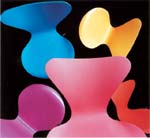 (-) No 7 chairs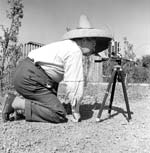 (Strüwing) Arne Jacobsen photographing in his own garden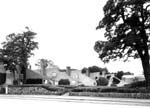 (Strüwing) Roughhouses (1950): Arne Jacobsen's own residence was in Søholm until his death in 1971.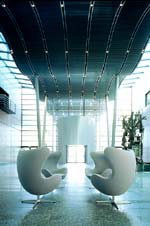 (-) Egg Chairs (1958); Manufacturer: Fritz Hansen A/S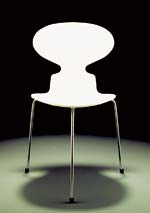 (-) Ant chair (3101), 1952; Manufacturer: Fritz Hansen A/S (Nicolai Perjesi) Candlesticks (1959); Manufacturer: Georg Jensen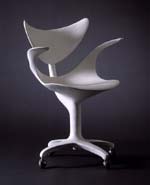 (Søren Nielsen) Prototype Office chair (1970); Fritz Hansen A/S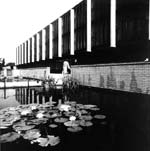 (Dissing + Weitling) St. Catherine's College, Oxford UK (1964)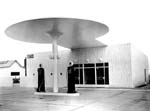 (Strüwing) Texaco Gas Station (1937); Kystvejen (Skovshoved)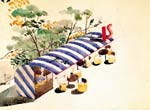 (Nicolai Perjesi/Kunstakademiets Bibliotek (KAB)) Ice booth (1930´s); costal baths, watercolor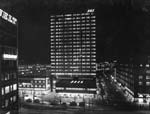 (Strüwing) SAS Royal Hotel (1960), at night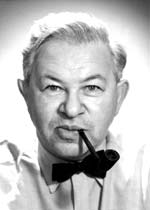 (Strüwing) Arne Jacobsen |
© 2002 ArchNewsNow.com